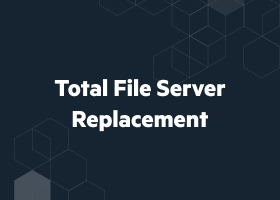Remote File Server
What Is a Remote File Server?
A remote file server is a system that allows applications running on client systems to access files from another system. Access is provided using local area networks (LANs), wide area networks (WANs), point-to-point links, internet connections, or other communication channels.
A remote file server is sometimes referred to as a distributed file system or a network file system. With a remote file server, users can remotely access files using any device without requiring a cumbersome virtual private network (VPN). A remote file server helps IT teams support growing and distributed teams by making it easy for users to access the information they need from any location securely.

Without the access provided with a remote file server, organizations suffer from:
- Missed deadlines.
- Negatively impacted business relationships.
- Reduced productivity.
The benefits of a remote file server:
Always on with a remote file server
Typical VPNs are offered without always-on capabilities, because they require more infrastructure components (e.g., authentication servers, compatible clients OS, and identity server). A remote file server provides always-on functionality to support the many cloud applications that are always on and require access to files. With a remote file server, applications and users can support online and offline access to files and folders, allowing them to be stored on local devices before they are synchronized.
Enhanced data security
With a remote file server, information is protected at rest and in transit with encryption and secure connections. A remote file server can also incorporate existing user access rules and permissions to control access to sensitive information to adhere to privacy requirements and enforce the principle of least privilege as part of a zero-trust security program.
Flexible file access
A remote file server simplifies access to file shares with user-friendly interfaces accessible on any device. Users can access information from a remote file server using a browser (e.g., Chrome, Firefox, Edge, and Internet Explorer), or files can be natively displayed by mapping drives file systems, such as Explorer and Finder. Whether a user is working within the organization’s network or offsite, they see the same content in the online shared folder as on an internal mapped drive.
Granular folder permissions
A remote file server supports granular file permissions that give IT admins control over and visibility into users’ access privileges. Permissions can be managed natively from the remote file server.
Improved Performance
A remote file server provides high-performance file transfers and sharing. Because a remote file server uses HTTP, file transfers are faster than a VPN. Traditional VPNs use the SMB/CIFS protocol, which is not a data streaming protocol and is unable to match the high performance delivered with a remote file server.
Increased productivity
A remote file server provides an always-on mapped drive that works anywhere, on any device, and allows mobile users to access internal file shares or cloud file servers easily. Windows file server network shares and shared drives can be turned into online shared folders protected by the same security measures as local file servers and managed by the same Active Directory.
Maintain compliance with a remote file server
A remote file server helps IT admins meet data protection and privacy standards to meet regulatory compliance standards and requirements. Additionally, with a remote file server, IT admins can easily perform compliance audits that include details about all changes to individual files (e.g., who made changes, when changes were made, and if the changed files were shared and with whom).
Offline editing
A remote file server supports offline editing, which allows remote users to edit and save files even if they do not have an active connection. With a remote file server, users can save the files asynchronously when they have a connection. This is far more practical than a traditional VPN that depends on a live connection to the corporate firewall to function. With a VPN, any disruption in the connection to the firewall interrupts users’ work, decreasing productivity and risking lost files.
Simplified file share access
Using a remote file server, internal users can easily collaborate with external third parties (e.g., customers, vendors, and partners) with the ability to share access to a limited set of internal files or folders. This feature of a remote file server allows sharing with outside users and retains administrative control. Additionally, a remote file server supports multi-site collaboration with features like version controls and file locking.
Streamlined management
With a remote file server, users, access controls, and storage for each tenant can be centrally managed. A remote file server allows IT admins to easily see precisely where data resides, who has access, and how it is being used and shared. Most remote file server solutions provide a central, web-based management portal to give IT teams a single-pane-of-glass interface to manage shared folders and files, as well as other objects in the management scope.
How Do File Servers Work?
A remote file server can be located on-premise, in a data center, or in the cloud. Hybrid deployments are also used for remote file server solutions. Wherever the remote file server resides, users access it via a network, usually a LAN, WAN, or internet connection. The remote file server’s operations are exclusively focused on file creation, editing, and sharing. Users (e.g., people and applications) access files from the remote file server for use on their devices and systems.
Remote file server access is restricted according to the organization’s rules. Usually, an identity service is employed for user authentication. Access to files and folders is protected by controls that enforce rules regarding rights to view, write, edit, and share.
What Is the Purpose of a File Server?
The main purpose of a remote file server is to allow multiple users to access the files and folders from any location or device. It provides a central storage repository that people or applications can use.
People who would use a remote file server include:
- Employees
- Contractors
- Vendors
- Partners
- Customers
Examples of applications that could use a remote file server are:
- Accounting programs
- Contract management systems
- Design programs
- Database programs
- ERP systems
Why Use a Remote File Server
The main reason for a remote file server is that it allows users to share files and folders over a network without having to physically transfer files. Following are several additional reasons why to use a remote file server:
- Centralize file storage
- Eliminate the need for a VPN
- Enforce the principle of least privilege
- Facilitate collaboration between internal and external users
- Give users an alternative to attaching files in an email to share them
- Improve data security
- Increase productivity
- Maintain compliance with regulatory requirements
- Provide easy remote access to files
- Streamline workflows
Egnyte has experts ready to answer your questions. For more than a decade, Egnyte has helped more than 22,000 customers with millions of customers worldwide.
Last Updated: 22nd January, 2024



